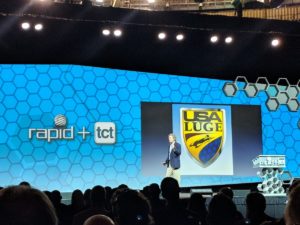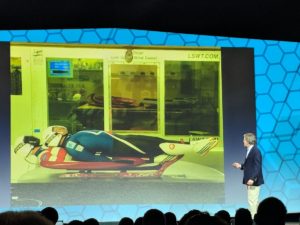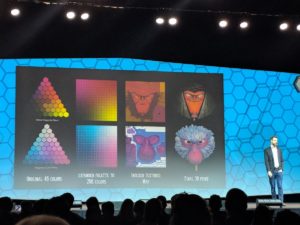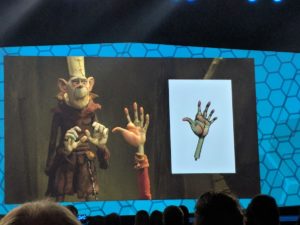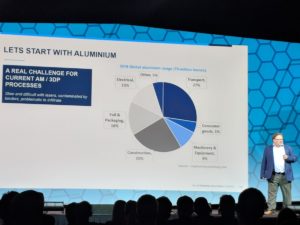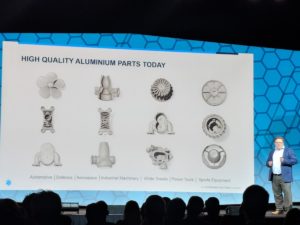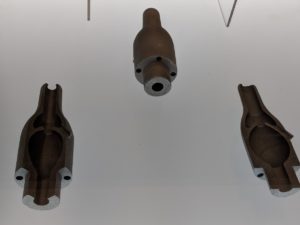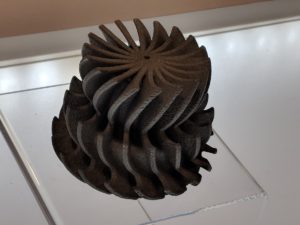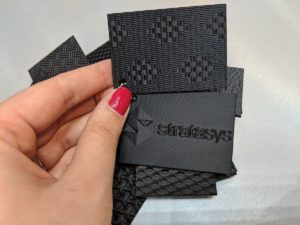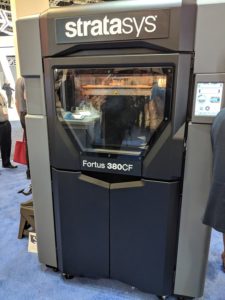 In the runup to RAPID + TCT 2018, we knew we had a lot to expect from 3D printing industry leaders including Stratasys. The Eden Prairie, MN-based company sponsored the opening keynote covering high-profile use cases from USA Luge and LAIKA and was set to unveil a highly-anticipated addition to its 3D printing portfolio with the announcement of a new metal technology.
In the runup to RAPID + TCT 2018, we knew we had a lot to expect from 3D printing industry leaders including Stratasys. The Eden Prairie, MN-based company sponsored the opening keynote covering high-profile use cases from USA Luge and LAIKA and was set to unveil a highly-anticipated addition to its 3D printing portfolio with the announcement of a new metal technology.
The keynote event, held ahead of the first full day of RAPID + TCT, followed welcomes from event organizers and a look into recent 3D printing announcements, as Rich Garrity, President, Stratasys Americas and Phil Reeves, PhD, Vice President – Strategic Consulting, Stratasys led the session entitled “From Hollywood to the Winter Games – Making Additive Manufacturing the Competitive Advantage for Innovation.”
Garrity began with several announcements from the company, as Stratasys introduced its new 3D printers, materials, and software capabilities. Among these were the enhanced J750 and new J735 3D printers, offering more than 500,000 color combinations, and the F900 Pro Fortus production 3D printer, as well as PEKK-based Antero 800NA FDM material already put to use in NASA’s Orion mission with Lockheed Martin.
Before getting into more news from the company, he introduced Jon Owen, Technical Programs Manager, at USA Luge.
“Who knew 3D printing could be so exciting?” Owen opened. “The technology is changing so fast, what I’m going to show you is already out of date.”
The US Olympic luge team put 3D printing to work for the 2018 Winter Olympics to enhance sled performance in a sport where thousandths of a second matter on sleds that go 80 mph. Pointing to a busy spreadsheet, Owen noted that to him that was what a sled looks like; there’s a lot of technology behind those little sleds, particularly for the trickier doubles events where two athletes must fit aerodynamically onto one little sled. Modern luge technology allows for 3D scanning, CAD design, and 3D printing molds to create new sleds that aren’t the one-size-fits all of yesteryear.
“In our world, in luge, it’s changing rapidly: lots of new ideas, lots of new technologies, it’s happening. This doubles technology I’ve just talked about today took us from an average of twelfth place in the Olympics to an average of sixth place in the Olympics,” Owen continued. “This technology is definitely what’s helping us out. In the end, we’re printing parts out and we’re going to the Olympics with them.”
Brian McLean, Director of Rapid Prototype, LAIKA, next shared a look into some of the studio’s storied history with 3D printing, as the team has been putting the technology to use for years now. He opened with a look into the art and science of LAIKA:
The work done at LAIKA has created stunning stop motion movies that include some of my personal favorites, and recognition of their remarkable art is well deserved. The work that goes into each is also staggering; McLean detailed some of this, including the production and hand painting of thousands of individual faces for Coraline. The 3D printed faces, made using Connex3 3D printers, allowed for a wider range of emotional depth than seen in previous (though also gorgeous) films; Jack Skellington of The Nightmare Before Christmas had about 500 possible facial expressions.
The exponential increase allowable via 3D printing puts more emotion and wonder into the characters, and Kubo and the Two Strings was the first film ever nominated at the Academy Awards in both the Animated Feature and Visual Effects categories. I’ve been delighted to see some of the pieces made for this film before, as the J750 and voxel-level control allowed for precision and color. LAIKA has been working with the J750 since 2015 and in 2016 the studio “got the first five off the assembly line,” McLean noted. The studio has just wrapped its fifth film, now in post-production.
LAIKA is using its J750 and Connex3 capabilities with Cuttlefish software from Fraunhofer that allows for slicing of models ahead of time.
McLean closed with a look into more of the effects from Kubo and I was certainly not the only person entranced by the movie magic captured in the short video:
Having shared successes of its existing technologies, Stratasys saved some of its larger announcements for the end of the keynote. While by this point in the late-running session more than a few attendees had already left the auditorium, those still sitting were somewhat rewarded in hearing more about the anticipated introductions from the company. Garrity noted that innovation is continuing with the H2000, developed with Boeing and Siemens, and first displayed at IMTS 2016 as the Infinite-Build 3D Demonstrator. The robotic composite system continues to progress.
“We are very pleased to announce development of our new Stratasys metals technology,” Garrity continued, bringing Reeves to the stage to share just a bit more.
Those hoping for a full system launch were left disappointed, as information shared was more an overview than an introduction to the technology, as yet unnamed, un-spec-ed, and undetailed. Still, as Reeves made clear: “There’s more to business than just product… There’s more to innovation than products.”
 Stratasys’ take on moving foward right now is based on a more systematic innovation, supported by research as the company continues to invest heavily into R&D.
Stratasys’ take on moving foward right now is based on a more systematic innovation, supported by research as the company continues to invest heavily into R&D.
“There’s a lot of different ways we can innovate our business,” Reeves explained. “Deloitte looked into how companies grow, and the strongest are the ones that have gone beyond just product innovation and have looked at system innovation, supply chain innovation, and more — that’s what excites me. 3D printing is about more than just making a 3D object. It allows us to think differently about how to use our materials, our supply chain. 3D printing enables more than product development; think not just about product development, think about full business innovations. We’ve done a lot of mapping over the last five or six years about where these benefits come from… benefits in efficiencies, being used to drive efficiencies in supply chains.”
The Stratasys Metal Platform, he continued, is about “moving metal additive manufacturing into short-run production” and the company’s vision begins with aluminum.
“We are using industry-standard materials and industry-standard economics to start an industry-standard workflow,” Reeves said.
Using proprietary Stratasys jetting technology, the platform is targeting applications in the automotive, defense, aerospace, industrial machinery, white goods, and other industries. With post-processing taken “down from hours to minutes with this process… the key teaser to leave you with is simply: high-density green state parts.”
Following these mainstage introductions, I was eager to sit down with the team for a quieter chat, and appreciated the opportunity to speak with Garrity, Reeves, and Senior Vice President of Sales Patrick Carey. We started where the keynote ended: with metal.
“We’ve been working for over three years on metal and gaining expertise,” Garrity told me, noting that the acquisition of Harvest Technologies — which also led to the development of new Stratasys spinoff Vulcan Labs — and a strategic investment into LPW Technology added to this expertise.
“We are using commonly available metals and leveraging our expertise in PolyJet. We’re at a point now where we’re slowly revealing more; the presentation yesterday was intended to peel back another layer of the onion. We have customers, working with the platform under NDA, working in aerospace, defense, automotive, and general industry.”
Reeves noted that the targets for Stratasys’ metal technology include “industries that historically would have looked at casting or MIM,” which extends to white goods, power tools, and automotive applications. There is, he says, “a lot of untapped market there.”
What’s important to users in these target application areas isn’t that they might consider 3D printing — it’s what any technology offers in terms of final quality.
“Qualities are what industry wants. Look at the metallurgy of what goes in is what comes out, with a raw material that is easily available,” Reeves continued.
Carey was kind enough to provide a few teaser hints for me, including that there is no binder in the part.
“There is no perfect solution yet for aluminum; it needs more energy to process than titanium. We need to architect something different,” Reeves continued of the choice to start with this focus.
Aluminum, a less costly raw material than titanium, is more reflective, rendering it more difficult to work with and requiring additional energy and cost, leaving additive solutions for the material wanting at present.
Through the company’s investments and acquisitions, Stratasys has access to what Carey describes as “probably more expertise in using DMLS than anyone.” This extensive experience feeds directly into the company’s plans for a new solution in metals.
With no more ready to share yet, the rest of that metal onion remains unpeeled for the immediate future, and conversation turned to Stratasys’ other announcements during the show. With applications and metals major themes through RAPID + TCT, we still had plenty to talk about.
The update to the J750, which Garrity noted as being what “we see as the gold standard for color prototyping” now sees more than 500,000 color capabilities for color matching in functional prototyping. This, he says, opens new markets including consumer goods:
“When you hold the part, it’s hard to tell the difference between the final part and the prototype.”
As Stratasys executives have noted before, this direct comparison to the final product enables a speedier time to market. A tail light made for Audi “looks identical to the finished product,” Garrity said, and indeed when I went to look at it later the (fairly significantly post-processed) finished piece was impressive. The new printheads also last 40% longer on the update, and the new J735 offers a junior version for users who don’t need such a large build.
- Audi tail light
- Surface textures possible with FDM 3D printing
Moving toward production, we discussed nylon capabilities that now extend to the Fortus line, PEKK capabilities in the new Antero material, and the offerings of the Fortus 900 for production. Repeatability was a major throughline for each of these developments, as well as the collection of data to support confidence. These, as well as the software announcements at the show that focus on monitoring and jigs and fixtures, make more available the expertise from the company for its users.
“We’re codifying our expertise; it spreads it out and helps adoption of additive,” Carey said.
“We’re making things simpler, making more available to users. Something as simple as ‘how rigid does it need to be’ – just let the software do it. Trust it, let it do its job for you,” Reeves summed up.
Speaking with the team was another appreciated opportunity to glimpse the mechanisms that make Stratasys run.
Today, the company also announced its Q1 financial results for 2018. Ultimately a “disappointing” performance, the company saw stock prices fall with the announcement and has a long road ahead to regain confidence and hope for rising revenues following a spate of declines. CEO Ilan Levin remarked in the release:
“We are disappointed with our revenue for the first quarter, which is primarily attributed to underperformance in North America related to high end system orders, specifically from customers in government and other key verticals such as aerospace and automotive. We do not believe that our first quarter revenue represents a fundamental change in the demand environment in the North American market. We continue to maintain a strong pipeline of opportunities, and are not modifying the full year guidance we issued earlier this year. Despite our revenue results in the period we continued our positive trend of operational discipline and cash generation. We remain committed to our investments in long-term initiatives that include advancements in our core FDM and PolyJet technologies, new metal additive manufacturing platform, advanced composite materials, and software and application development.”
Full results are available here.
Discuss Stratasys, aluminum, LAIKA, luge, and other 3D printing topics at 3DPrintBoard.com or share your thoughts in the Facebook comments below.
[All photos: Sarah Goehrke]
Subscribe to Our Email Newsletter
Stay up-to-date on all the latest news from the 3D printing industry and receive information and offers from third party vendors.
You May Also Like
Gorilla Sports GE’s First 3D Printed Titanium Cast
How do you help a gorilla with a broken arm? Sounds like the start of a bad joke a zookeeper might tell, but it’s an actual dilemma recently faced by...
Nylon 3D Printed Parts Made More Functional with Coatings & Colors
Parts 3D printed from polyamide (PA, Nylon) 12 using powder bed fusion (PBF) are a mainstay in the additive manufacturing (AM) industry. While post-finishing processes have improved the porosity of...
$25M to Back Sintavia’s Largest Expansion of Metal 3D Printing Capacity Since 2019
Sintavia, the digital manufacturing company specializing in mission-critical parts for strategic sectors, announced a $25 million investment to increase its production capacity, the largest expansion to its operations since 2019....
Velo3D Initiates Public Offering in a Bid to Strengthen Financial Foundations and Drive Future Growth
Velo3D (NYSE: VLD) has been among a number of publicly traded 3D printing firms that have attempted to weather the current macroeconomic climate. After posting a challenging financial report for 2023,...




